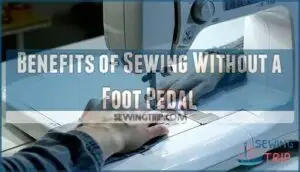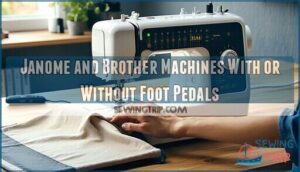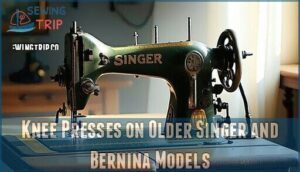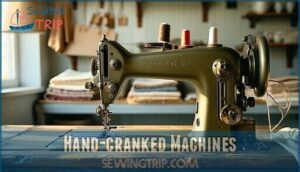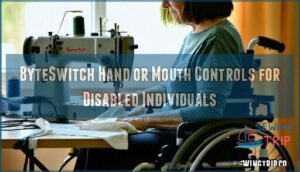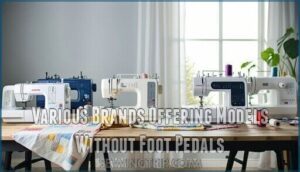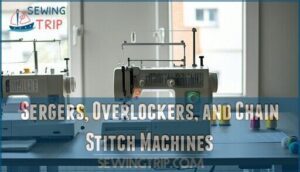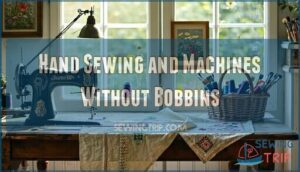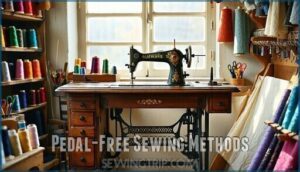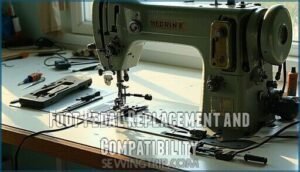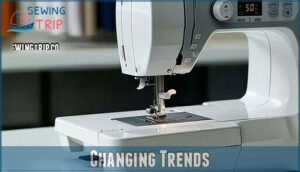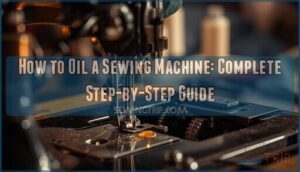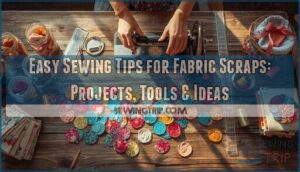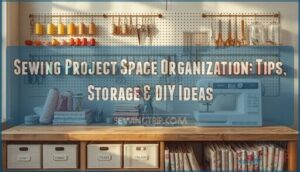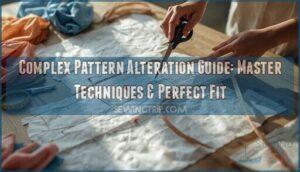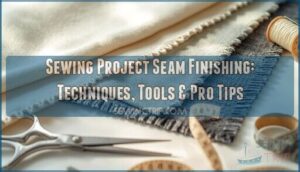This site is supported by our readers. We may earn a commission, at no cost to you, if you purchase through links.
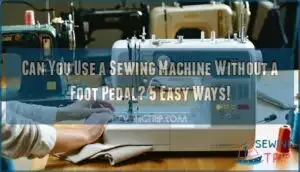
You’ll find this feature on various Janome, Brother, and other brand models. Some machines also include speed control settings, giving you consistent stitching at your preferred pace.
Alternative options include knee presses on vintage machines, hand-crank models, or specialized adaptive controls for those with mobility needs.
This hands-free approach actually offers better control for precision work like free-motion quilting. The key is finding which pedal-free method works best for your specific sewing style and machine capabilities.
Table Of Contents
Key Takeaways
- You can replace foot pedals with start/stop buttons – Modern computerized machines from Janome and Brother let you control stitching speed using push-button controls and speed dials instead of coordinating your feet.
- Alternative control methods expand your options – You’ll find knee presses on vintage machines, hand-crank models for manual operation, and specialized adaptive controls like ByteSwitch for those with mobility limitations.
- Pedal-free sewing improves precision and comfort – You’ll maintain consistent stitching speeds without variable pedal pressure, reduce leg fatigue, and gain better control for detailed work like free-motion quilting and embroidery.
- Most machines can operate without their original pedals – You can unplug existing foot pedals on computerized models, use universal replacement pedals between compatible machines, or convert older machines with hand-crank systems.
Sewing Machine Without a Foot Pedal
Countless sewists have discovered they can break free from foot pedal dependency and gain complete control over their stitching. You’re not tied to traditional pedal operation when modern sewing machines offer pedal free sewing alternatives that enhance machine ergonomics and improve your sewing posture.
Many computerized machines from Janome and Brother work perfectly as a sewing machine without foot pedal. These models feature built-in speed settings and push-button controls that let you focus entirely on fabric control without coordinating your hands and feet. You’ll find your thread tension remains consistent when you’re not juggling pedal pressure.
Older Singer and Bernina machines used knee presses for pedalless sewing, while ByteSwitch creates hand or mouth controls specifically for foot pedal alternative needs. Hand-cranked machines offer the ultimate in sewing without pedal precision.
This shift toward pedal-free operation isn’t just trendy—it’s practical. You can stretch your legs, adjust your workspace, and maintain better posture while achieving superior stitch quality through steady, controlled needle movement. Using portable sewing machines can also provide more flexibility and convenience for sewists.
Benefits of Sewing Without a Foot Pedal
You’ll discover that sewing without a foot pedal offers several practical advantages that can improve your stitching experience.
These benefits range from enhanced precision control to better ergonomics during extended sewing sessions, which can lead to a more enjoyable and efficient sewing process with better ergonomics.
Constant Stitching Speed
When you remove foot pedal variables from the equation, steady stitching becomes your new superpower.
**When you remove foot pedal variables from the equation, steady stitching becomes your new superpower.
Your sewing machine speed stays rock-solid consistent, eliminating those frustrating speed fluctuations that can ruin delicate work.
Here’s why constant pace transforms your sewing:
- Predictable Results: No more guessing how fast you’re going mid-seam
- Reduced Fatigue: Your leg gets a break from constant pedal pressure
- Better Focus: Concentrate on fabric placement instead of speed control
- Precise Sewing: Maintain exact timing for professional-looking stitches
This pedal free sewing approach gives you complete mastery over your machine’s rhythm, making every project more manageable.
Ideal for Free Motion Quilting and Embroidery
Beyond maintaining constant stitching speed, you’ll discover that pedal free machine operation transforms your free motion quilting and embroidery experience.
When you’re hands free sewing, your focus shifts entirely to fabric manipulation and stitch control.
Free motion quilting becomes more intuitive without coordinating foot pressure with hand movements. You can guide fabric smoothly while maintaining consistent sewing speed.
This control proves invaluable for embroidery techniques requiring precise needle placement.
Here’s what pedal-free operation delivers:
- Complete focus on fabric positioning without pedal distractions
- Steady rhythm for consistent stitch formation
- Enhanced precision when following quilting patterns
- Reduced fatigue during extended sewing sessions
- Better stability for intricate embroidery work.
Professional quilters often prefer this setup because it eliminates speed variations that can affect stitch quality.
Your hands remain free to manipulate fabric exactly where needed, creating smoother curves and more accurate pattern following.
The consistent pace helps develop muscle memory for complex quilting tips and embroidery techniques, making sewing without foot pedal operation a game-changer for detailed work.
Easier Control for Sewing Tricky Tasks
You’ll find that tricky tasks become much more manageable when you’re not juggling foot pedal coordination.
Maneuvering tight corners, sewing curves, and tackling intricate details requires your full attention on fabric manipulation rather than speed control.
A pedal free machine gives you steady control at constant speed, letting you focus entirely on guiding your fabric.
This hands free sewing approach transforms challenging projects like appliqué work or detailed topstitching from stressful to enjoyable.
| Tricky Task | Pedal-Free Advantage |
|---|---|
| Sharp corners | Precise stitching without speed fluctuation |
| Curved seams | Better fabric control with both hands |
| Appliqué work | Slow speed maintains accuracy |
| Detailed topstitching | Alternative control methods reduce errors |
| Buttonholes | Steady, consistent stitch formation |
When sewing without foot pedal control, you’re free to position your hands exactly where they’re needed most for ideal results.
Slow Stitch Option for Precision
Your machine’s slow stitch option transforms precision sewing into an art form.
This foot pedal alternative gives you complete stitch control at a constant speed, perfect for detailed embroidery and intricate fabric manipulation.
- Master delicate curves with steady, controlled stitches
- Perfect appliqué edges without rushing or hesitation
- Navigate tight corners with confidence and accuracy
- Control free motion quilting patterns effortlessly
Slow speed sewing machine control eliminates guesswork, letting you focus entirely on creating flawless results.
Alternative Control Methods
You’ll find several practical alternatives when your foot pedal breaks or you want hands-free control.
Modern computerized machines from Janome and Brother offer push-button speed control, while older Singer and Bernina models feature knee presses for seamless operation.
Janome and Brother Machines With or Without Foot Pedals
Modern Janome and Brother machines give you complete control over your sewing speed without a foot pedal.
Simply unplug the pedal and use the start/stop button with speed slider for consistent stitching.
These computerized models feature ergonomic design with machine controls right at your fingertips.
You’ll discover pedalless sewing offers superior precision for detailed work, letting you focus entirely on fabric manipulation while maintaining steady sewing speed through alternative methods.
Additionally, using a dual function controller can enhance your sewing experience with hands-free operation and improved efficiency.
Knee Presses on Older Singer and Bernina Models
While modern machines offer computerized controls, vintage machines like older Singer and Bernina models featured knee presses for hands-free operation.
You’d simply push the knee lever to start stitching, keeping your hands free for fabric control. This vintage sewing machine operation method offered seamless alternative control methods before foot pedal replacement became standard.
Benefits of knee press controls:
- Freedom of movement – Your hands stay focused on guiding fabric
- Standing comfort – Perfect for tall sewers or those preferring upright positions
- Precision control – Smooth start-stop action for detailed work
- Accessibility option – Great for those with foot mobility limitations
These older models prove that Singer Bernina pioneered creative sewing controls long before today’s pedal-free innovations.
Hand-cranked Machines
Vintage handcranked machines offer you complete control over your stitching speed through manual operation.
These pedal alternatives rely on crank handles that you turn by hand, giving you precise command over each stitch.
Hand operation lets you master sewing mechanics at your own pace without electrical dependence.
You’ll find handcranked machines perfect for pedalfree sewing when you need ultimate precision.
The hand crank system provides steady, controlled stitching that’s ideal for delicate fabrics or intricate work.
These manual controls eliminate the variable speed issues common with foot pedals.
Sewing without a table becomes easier with portable hand-cranked models.
You can position yourself comfortably and maintain consistent rhythm through the crank mechanism.
The physical engagement helps you develop better stitch awareness and fabric control.
While slower than electric machines, hand-cranked models excel at teaching proper sewing fundamentals and building muscle memory for consistent stitching.
They provide a unique advantage in terms of control and precision, making them ideal for certain types of sewing projects.
Handcranked machines are particularly useful for delicate fabrics or intricate work, where precision and control are crucial.
ByteSwitch Hand or Mouth Controls for Disabled Individuals
ByteSwitch’s hand and mouth controls transform sewing accessibility for people with disabilities.
These adaptive controls replace foot pedals entirely, using pressure sensors for precise speed control.
- Hand controls: Squeeze-activated devices that mount on tables or lapels
- Mouth controls: Pneumatic systems responding to breath pressure variations
- Universal compatibility: Works with most electronic sewing machines via plug-in replacement
This assistive technology empowers sewers with spinal cord injuries or lower extremity limitations, making inclusive design a reality.
The sewing community benefits from accessibility support that enhances the overall sewing experience for users with various needs.
Sewing Machines Without Foot Pedals
Several manufacturers now produce sewing machines designed to operate without foot pedals, giving you more control options for your projects.
You’ll find these pedal-free models across different machine types, including computerized machines with push-button controls, sergers with built-in speed settings, and even specialized hand-crank models that let you stitch at your own pace.
Various Brands Offering Models Without Foot Pedals
You’ll find plenty of sewing machine brands offer pedal free options.
Janome models like the 230DC and CXL301 feature pushbutton control for hands-free operation. Brother options include the Innov-is series with alternative control methods built right in.
These sewing machine brands understand that foot pedal alternatives give you freedom to focus on your fabric instead of coordinating your feet.
Many sewers appreciate the convenience of pedal free sewing machines for their projects, because they provide hands-free operation and allow for alternative control methods.
Sergers, Overlockers, and Chain Stitch Machines
Since sergers and overlockers use loopers instead of traditional bobbins, you’ll find many models operate beautifully with alternative control methods.
These machines often feature knee-lift systems or programmable start/stop buttons that eliminate foot pedal dependency.
Chain stitch machines excel with manual handwheel controls, giving you precise sewing speed control for decorative work.
Machine maintenance becomes simpler too—fewer moving parts mean less hassle when following overlocker tips for peak performance.
Hand Sewing and Machines Without Bobbins
Hand sewing remains the go-to method when you can’t access a sewing machine without foot pedal or need quick fixes.
Sewing Basics come naturally with these Machine Types alternatives that offer complete Thread Control.
- Mending small tears – Perfect for emergency repairs
- Attaching buttons – No bobbin needed, just steady hands
- Hand embroidery – Creative Sewing Techniques without electricity
- Applique work – Precise fabric placement using hand controls
Bobbin Free options eliminate foot pedal replacement cost while giving you complete control over your stitching speed and precision.
Pedal-Free Sewing Methods
You can operate your sewing machine without electricity by using treadle-powered machines or hand-crank conversions that rely on mechanical energy instead of electrical power.
These pedal-free methods work well for portable sewing, off-grid crafting, or when you want complete control over your stitching speed through manual operation.
Treadle Machines and Their Use in Less Developed Countries
Treadle machines offer Manual Sewing freedom in regions where electricity remains unreliable.
These foot pedal-powered machines provide Rural Access to sustainable sewing technology at Low Cost.
In Uganda, 80% of rural treadle machines come from China, enabling women to start tailoring businesses.
You’ll find these Treadle Power machines supporting livelihoods across Africa and Asia, proving Sustainable Sewing doesn’t require modern infrastructure.
The treadle machines also require regular thread tension checks to guarantee smooth operation and prevent thread breakage.
Converting Modern Machines to Operate Without Electricity
Converting modern machines to operate without electricity opens up new possibilities for off-grid sewing.
You can retrofit your computerized sewing machine with alternative power sources when the grid fails.
Here are practical conversion options:
- Hand Crank systems that replace electric motors with manual power
- Solar Sewing setups using portable panels and battery storage
- Treadle Conversion kits that adapt modern machines for foot-powered operation
- Manual Power generators that store kinetic energy for consistent stitching.
These handsfree systems maintain sewing machine control without traditional foot pedal dependency.
Sewing Machines Without a Table or Stand
You can absolutely use portable sewing and compact machines without traditional tables.
Many handheld devices and lap sewing options give you freedom to work anywhere.
Simply sit cross-legged and hold your machine securely in your lap.
These space saving solutions work perfectly with hand controls, pushbutton operation, or knee pedal alternatives, making any cozy corner your sewing studio.
Sewing Without a Presser Foot
Beyond tables and stands, your fabric movement becomes the star when you skip the presser foot entirely.
This technique opens up creative possibilities while demanding careful attention to thread tension and stitch quality. Your sewing posture shifts as you guide fabric manually through the machine.
- Hand-guided fabric feeding – Control speed and direction without mechanical assistance
- Free-motion embroidery work – Create artistic designs with unrestricted fabric movement
- Basting and temporary stitches – Quick assembly without presser foot constraints
- Delicate fabric handling – Prevent damage to sensitive materials like silk or lace
- Custom stitch formations – Achieve unique effects impossible with standard presser feet
This sewing machine alternative requires practice but rewards you with unprecedented creative control over your projects.
Foot Pedal Replacement and Compatibility
If your foot pedal breaks or stops working, you don’t have to panic about expensive replacements.
Most sewing machines can accept universal foot pedals, and you can often swap pedals between compatible machine models to keep sewing.
Universal Foot Pedals and Compatibility
While universal foot pedals seem like magic bullets, they’re not truly universal.
Compatibility depends on plug type, voltage, and wiring configuration. Before purchasing, check your machine’s connector against product photos and consult your owner’s manual.
Mismatched pedals can damage your machine or create safety hazards. Test any replacement pedal thoroughly for proper speed control and needle response.
When selecting a new pedal, consider the importance of proper foot pedal compatibility to guarantee safe and effective operation, see foot pedal compatibility for more information.
Replacing Foot Pedals and Interchanging Between Machines
Swapping foot pedals between different sewing machines isn’t always straightforward.
You’ll need to verify compatibility before attempting any machine conversion or pedal replacement to avoid damaging your equipment.
Check these compatibility factors:
- Model specifications – Confirm voltage and amperage ratings match exactly
- Connector types – Verify plug sizes and pin configurations align properly
- Control mechanisms – Confirm electronic versus mechanical foot control systems
Smart sewers research pedal alternatives and sewing adaptation options before investing in expensive replacements.
Interchangeable foot pedals work best within the same brand family, though pedal replacement cost varies substantially across manufacturers.
Checking The Owner’s Manual for a Compatible Replacement
Your sewing machine manual contains the roadmap to compatibility success.
Check the owner guidance section for specific replacement parts and model numbers before purchasing. Manual checks prevent compatibility issues that’ll leave you frustrated.
The manufacturer lists approved pedal alternatives and replacement options for your exact model. Don’t guess – your owners manual knows best.
Understanding foot pedal repair is also essential for maintaining your sewing machine’s performance and extending its lifespan.
Changing Trends
The sewing industry continues shifting toward more inclusive designs that accommodate various physical abilities and preferences.
You’ll find manufacturers now prioritize alternative control methods like push-button operation and hand controls, making sewing accessible for everyone regardless of mobility limitations, which promotes inclusive designs.
Replacement of Foot Pedals With Other Control Methods
Modern replacement options give you complete control over stitching speed and precision.
Push buttons and electronic controllers eliminate foot coordination challenges.
- Hand Controls: Palm-operated devices and modified table-mounted foot pedal alternatives
- Knee Presses: Vintage Singer and Bernina knee pedal systems for hands-free operation
- Mouth Operated: ByteSwitch alternative activators designed for severe mobility limitations
Hand crank machines offer mechanical precision without electronic controllers entirely.
Benefits for Individuals With Disabilities Who Cannot Use Foot Pedals
When physical disabilities limit your ability to use traditional foot pedals, adaptive sewing technology opens doors you might’ve thought were closed forever.
Assistive technology transforms sewing accessibility through innovative solutions like ByteSwitch hand and mouth controls, which let you operate machines with minimal physical strain.
These accessibility options include removable pedals for amputees, knee controls for limited leg mobility, and hand-operated systems for upper body movement.
Inclusive design in modern machines supports disability support by offering multiple control methods. You’ll find sewing machine compatibility extends across brands, ensuring adaptive sewing remains affordable and practical.
Standing tables accommodate wheelchair users, while hand-cranked machines serve those with severe mobility limitations, proving that benefits for individuals with disabilities include creative independence and therapeutic engagement.
Understanding the importance of speed control systems is essential for individuals adapting to new sewing methods.
Frequently Asked Questions (FAQs)
Does a Singer sewing machine have a foot pedal?
Why wouldn’t your trusty Singer come equipped with its faithful foot companion?
Yes, Singer sewing machines typically include foot pedals as standard equipment, giving you hands-free speed control for precise stitching.
Can you sew without a foot pedal?
Yes, you can absolutely sew without a foot pedal!
Many computerized machines offer push-button controls that let you adjust speed with dials or buttons, giving you hands-free operation and steady stitching for precise work.
Do sewing machines require foot pedals?
Sewing solutions aren’t strictly stuck to foot pedals. Many modern machines offer button-based controls, letting you start and stop stitching with your hands instead of feet for greater precision.
How to use a sewing machine?
Thread your machine, choose your stitch, and adjust speed using the dial or buttons.
Position fabric under the presser foot, lower it, then press start.
Guide fabric smoothly as the needle creates your stitches effortlessly, with the machine working to make the process easier.
Can you sew on a Janome machine without a foot pedal?
Practically perfect Janome machines let you stitch without pedals using push-button controls on computerized models.
You’ll find speed dials and start/stop buttons that give you complete control over your stitching pace and precision.
Do all sewing machines have knee pedals?
Most sewing machines don’t have knee pedals. Only older Singer and Bernina models featured knee controls for hands-free operation. Today’s machines typically use foot pedals or push-button controls instead.
Do you need a foot pedal for sewing?
No, you don’t need a foot pedal for sewing.
Many modern machines offer button controls, speed dials, or computerized settings that let you stitch hands-free, giving you better control and precision.
Can sewing machines run on battery power?
Yes, some sewing machines can run on battery power, though they’re less common than plug-in models.
You’ll find portable battery-powered machines perfect for travel or outdoor projects where electrical outlets aren’t available.
How to clean machines without foot pedals?
Clean pedal-free machines by unplugging them first, then wiping exterior surfaces with a damp cloth. Remove the needle plate and clean underneath with a small brush to eliminate lint buildup.
Do all computerized machines support pedal-free operation?
Imagine trying to drive a car where only half the models come with steering wheels – that’s how computerized sewing machines work with pedal-free operation.
Not all computerized machines support this feature, but many modern Brother and Janome models do offer button-activated controls alongside traditional pedals.
Conclusion
Whether you’re seeking consistent stitching speeds, precise control for detailed work, or accommodation for physical needs, you can absolutely use a sewing machine without a foot pedal.
Modern machines offer start/stop buttons and speed controls that deliver reliable results.
Alternative methods like knee presses, hand-crank systems, and adaptive controls expand your options further.
These pedal-free approaches often provide better control for intricate tasks, allowing you to choose the method that matches your sewing style and physical requirements for precise control.

